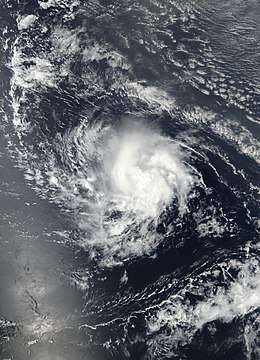Hurricane Isaac (2018)
Hurricane Isaac was a minimal hurricane that affected the Lesser Antilles in September 2018. Isaac originated from a tropical wave the west coast of Africa. The system gradually organized over the next several days. After a burst of deep convection on September 6 and then the development of a well-defined center shortly after, a tropical depression formed about 690 mi (1,110 km) west of the Cabo Verde Islands around 12:00 UTC on September 7. Weak steering currents caused the depression to initially move slowly, while moderate wind shear temporarily prevented the system from strengthening. At 12:00 UTC on September 8, the depression intensified into Tropical Storm Isaac. With warm ocean temperatures, abundant moisture, and low wind shear, Isaac intensified into a hurricane at 00:00 UTC on September 10. Simultaneously, the cyclone peaked with sustained winds of 75 mph (120 km/h) and a minimum pressure of 995 mbar (29.4 inHg). Later on September 10, dry air entered the storm's small circulation, suppressing convection and preventing any further intensification. Increasing wind shear generated by an upper-level trough to the north caused Isaac to weaken, with the cyclone falling to tropical storm intensity early on September 11. Between September 12 and September 13, the system's surface circulation became exposed from the convection. Persistent wind shear caused Isaac to weaken to a tropical depression early on September 15 and then degenerate into a tropical wave about halfway between the Dominican Republic and Venezuela shortly thereafter.
| Category 1 hurricane (SSHWS/NWS) | |
 Hurricane Isaac at peak intensity well to the east of the Lesser Antilles on September 10 | |
| Formed | September 7, 2018 |
|---|---|
| Dissipated | September 15, 2018 |
| Highest winds | 1-minute sustained: 75 mph (120 km/h) |
| Lowest pressure | 995 mbar (hPa); 29.38 inHg |
| Fatalities | None |
| Damage | Minimal |
| Areas affected | West Africa, Lesser Antilles, Haiti, Jamaica, Cayman Islands, Cuba |
| Part of the 2018 Atlantic hurricane season | |
Isaac caused heavy rainfall, minimal flash flooding, and mudslides across the Lesser Antilles. Strong winds also caused widespread power outages on some islands.
Meteorological history
On September 2, a tropical wave exited the west coast of Africa. The system gradually organized over the next several days. After a burst of deep convection on September 6 and then the development of a well-defined center shortly after, a tropical depression formed about 690 mi (1,110 km) west of the Cabo Verde Islands around 12:00 UTC on September 7. Weak steering currents caused the depression to initially move slowly, while moderate wind shear temporarily prevented the system from strengthening. At 12:00 UTC on September 8, the depression intensified into Tropical Storm Isaac. Thereafter, the cyclone began moving westward between 12 and 17 mph (19 and 27 km/h) after a subtropical ridge situated north of the storm strengthened. With warm ocean temperatures, abundant moisture, and low wind shear, Isaac intensified into a hurricane at 00:00 UTC on September 10. Simultaneously, the cyclone peaked with sustained winds of 75 mph (120 km/h) and a minimum pressure of 995 mbar (29.4 inHg).[1] Later on September 10, dry air entered the storm's small circulation, suppressing convection and preventing any further intensification. Increasing wind shear generated by an upper-level trough to the north caused Isaac to weaken, with the cyclone falling to tropical storm intensity early on September 11. Between September 12 and September 13, the system's surface circulation became exposed from the convection. Around 12:00 UTC on September 13, Isaac passed between Martinique and Dominica, with the high terrain on Martinique nearly causing the storm to dissipate. Although convection briefly re-developed, persistent wind shear caused Isaac to weaken to a tropical depression early on September 15 and then degenerate into a tropical wave about halfway between the Dominican Republic and Venezuela shortly thereafter.[1]
Preparations and impact
In advance of Isaac, the NHC posted a tropical storm warning for Martinique, Dominica, and Guadeloupe. A tropical storm watch was also posted for Antigua, Montserrat, St Kitts and Nevis, Saba, St Eustatius, and Saint Martin.[2]
On Dominica, the cyclone caused minor flooding and mudslides.[1] Wind gusts peaked at 53 mph (86 km/h) on Guadeloupe, causing hundreds of power outages.[3] Locally heavy rainfall on Saint Lucia caused flooding in Anse La Raye and Castries, while winds downed trees in Barre de L'isle.
See also
- Tropical Storm Kirk (2018) - Affected similar areas nearly 2 weeks after Isaac.
- Hurricane Matthew - Affected similar areas while still a tropical storm.
- Tropical Storm Erika (2015) - Caused severe damage in similar area said in August 2015.
References
- David A. Zelinsky (January 30, 2019). Tropical Cyclone Report: Hurricane Isaac (PDF) (Report). Miami, Florida: National Hurricane Center. Retrieved January 31, 2020.
- https://www.al.com/news/2018/09/tropical_storm_isaac_update_is.html. Missing or empty
|title=(help) - "Tempête Isaac : en Martinique et en Guadeloupe, plus de peur que de mal". France 24 (in French). Agence France-Presse. September 14, 2018. Retrieved January 31, 2020.